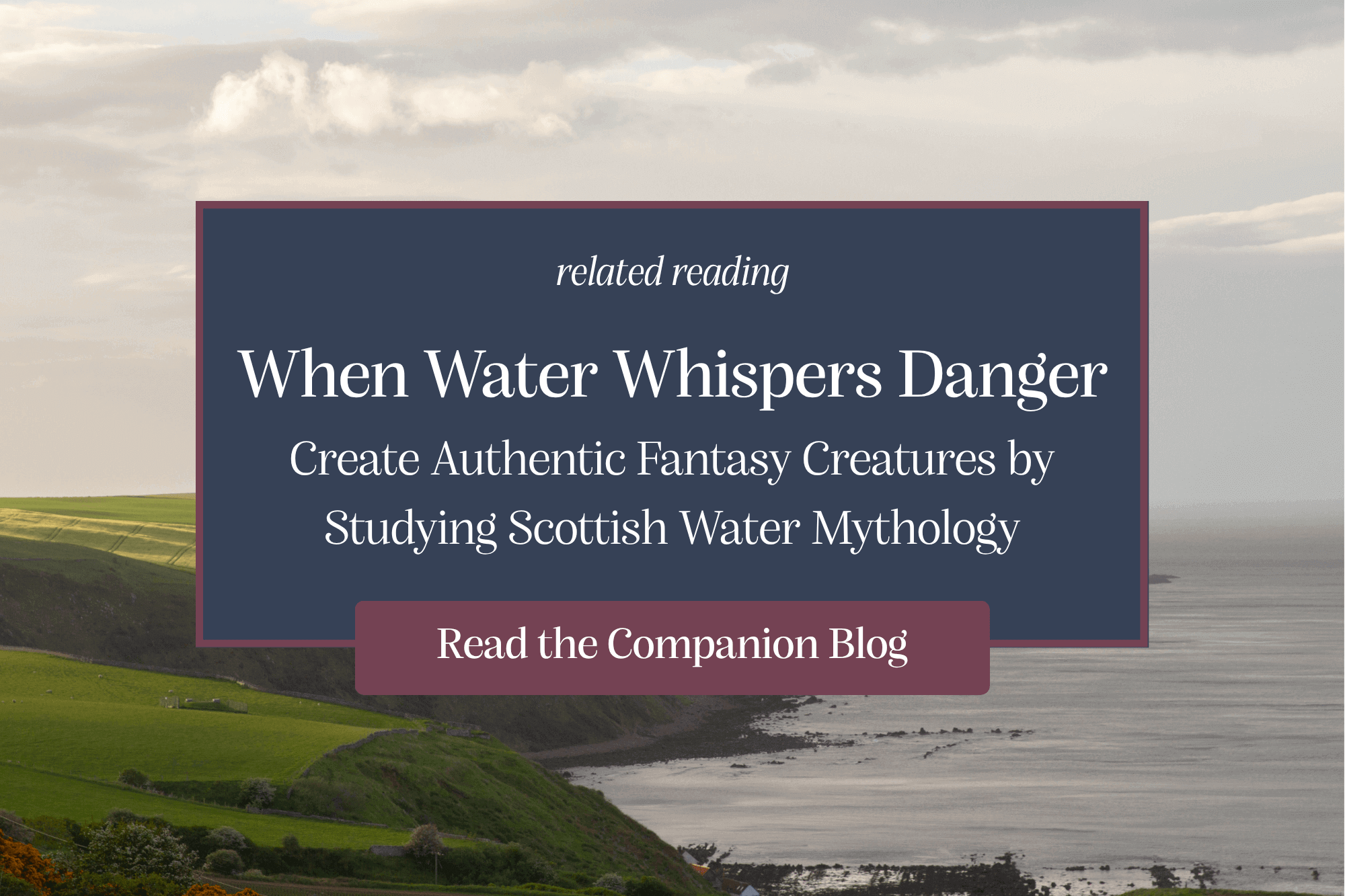Magic in the Mundane: What Scottish Household Spirits Teach About Sustainable Fantasy
Part 2 of The Scottish Storyteller's Toolkit series
Magic in the Mundane
What if I told you that one of the most compelling magic systems in literature involves...doing the dishes?
Scottish Brownies prove that extraordinary fantasy writing can bloom in the most ordinary places.
While American fantasy often chases bigger explosions and more spectacular spells, Scottish household spirits understand something crucial: sustainable fantasy isn't about escalating power—it's about magic that enhances daily life rather than disrupting it.
Sound counterintuitive? Let me show you why Brownies might just revolutionize your approach to fantasy world-building.
The Problem with Spectacular Magic
American fantasy often falls into two related traps.
First, the "Chosen One" trap—magic is rare, coveted, and hoarded.
Second, what we might call the "Nuclear Option" trap—where magic only comes in size XXL. Dragons level cities, wizards reshape landscapes, and every spell has earth-shattering consequences.
In this "go big or go home" approach, there's no such thing as modest magic.
Every magical moment needs explosions, cosmic stakes, or reality-bending power. It's as if nothing smaller than size 10 magic exists in the author's toolkit.
Both traps create the same sustainability problem that every series writer knows intimately: How do you maintain wonder across multiple books when every magical moment must be MORE spectacular than the last?
By book three, your mage is splitting mountains.
By book five, they're reshaping reality itself.
By book seven, they're rewriting the laws of physics. So…where do you go from there?
Scottish household spirits don't have this problem. Why?
Because they understand that magic belongs to ALL creatures, and the most powerful magic isn't the kind that destroys worlds—it's the kind that quietly improves them.
After all, in a truly magical world, wouldn't creatures of every size possess some form of magic? The "Nuclear Option" approach feels almost arrogant—as if small creatures are beneath notice or unworthy of magical abilities.
Scottish tales recognize that a three-foot Brownie can be just as magically significant as any dragon, because magic scales to serve the needs of its wielder, not to impress observers.
The Brownie Model: Magic as Partnership
Meet the Brownie: a three-foot-tall household spirit who does chores at night in exchange for milk, cream, and respect.
They're fantasy creatures that embody a completely different approach to magic systems than what’s become popular (and overused) in American fantasy in recent years.
In Scottish folklore, Brownies prove that small doesn't mean powerless.
Their magic is perfectly calibrated to their world: domestic, practical, and essential. They don't need to level mountains because their power lies in transforming daily life.
This realistic magical ecosystem acknowledges that in a world where magic exists, it can manifest at every scale.
Brownies work eagerly for families who appreciate them, completing tasks like cleaning, cooking, and farm work while everyone sleeps. But here's what makes them brilliant for writing craft: they're not magical servants—they're magical partners with their own needs, pride, and emotional complexity.
They expect genuine gratitude, not payment. They can take offense if they feel unappreciated or insulted. And if truly offended, they can turn malicious or simply leave—taking their invaluable help with them.
How Scotland's Geography Gave Birth to the Brownie
The Brownie myth emerged from Scotland's rural farming landscape, where survival depended on completing endless daily tasks before harsh weather set in.
Scottish farms were often isolated, miles from neighbors, making every pair of hands precious. The short growing seasons and unpredictable Highland weather meant that falling behind on work could spell disaster for an entire family.
In this context, the fantasy of a helpful spirit who could complete tasks overnight wasn't just wish fulfillment—it was survival dreaming.
The Brownie represents the Scottish understanding that magic should serve practical needs, not grandiose ambitions. Unlike the flashy magic of warmer climates, Scottish supernatural aid focused on the daily grind: milking cows, grinding grain, mending tools.
The Brownie's attachment to specific homes reflects the geographic reality of Scottish settlement patterns, where families might live in the same farmhouse for generations, making the land an extension of family identity.
How Geography Adds Emotional Truth to the Brownie:
Magic that serves daily life creates more sustainable conflict than magic that serves grand destinies.
The Brownie's emotional complexity—pride, loyalty, sensitivity to disrespect—mirrors the real dynamics of Scottish rural communities where reputation and mutual respect were essential for survival.
This geographic grounding makes Brownie relationships feel authentic because they echo real human dynamics in close-knit, isolated communities.
Scottish families had to maintain long-term relationships with neighbors because there was no one else to turn to during harsh winters or failed harvests. The Brownie's ability to hold grudges, leave permanently if offended, or become malicious when mistreated reflects these high-stakes social dynamics.
When writers ground their household magic in geographic and social realities—whether urban apartment spirits who understand city rhythms or desert creatures who give (or hoard) water—their magical systems gain authentic weight in the minds of readers.
If you want to dive deeper into how geography shapes compelling fantasy creatures, check out Part 1 of this series on Scottish water mythology.
The Respect Economy: Magic with Emotional Intelligence
But here's where Brownies get really interesting for character development: they operate on an economy of respect and relationship rather than power or payment.
The most famous example is the Brownie of Bodesbeck Farm. For years, this industrious spirit turned the farm into the most prosperous in southern Scotland. Every morning, the farmer would wake to find his chores completed. Through the Brownie's tireless work, the farm flourished.
But one day, the grateful farmer decided his hardworking helper deserved a more substantial meal, and left out a feast instead of the usual bowl of milk.
The Brownie was insulted. Didn't the farmer understand that the Brownie took only what he needed?
The implication that the farmer could decide what was an "appropriate" meal for the Brownie destroyed the partnership's foundation.
By morning, the Brownie had vanished. Without their supernatural assistance, the farm's fortunes slowly reversed. Neighbors whispered that the prosperity had moved to Leithin Hall—where the Brownie had relocated.
What This Teaches About Sustainable Magic Systems:
Relationships with magic and creatures require understanding, not just transaction
Small misunderstandings can have major plot consequences
Magic that can leave becomes more precious than magic that's immobile
Emotional intelligence can create more compelling conflicts than raw power
Small Magic, Big Stakes
Here's the beauty of the Brownie model: modest magical help, consistently applied, creates significant long-term impact.
A satisfied Brownie can make a farm the most prosperous in the region, while their departure can lead to financial ruin.
This fantasy writing technique creates sustainable tension because the stakes are always meaningful but never apocalyptic. The world doesn’t have to end for the stakes to be high. A family’s future, a farm’s fate - these have the power to shape a person’s life.
The Invisibility Advantage: Hidden Magic Feels More Real
Brownies work unseen, in unused corners of homes. This atmospheric writing technique makes magic feel believable because it operates alongside normal life rather than replacing it.
When magic is hidden, readers can imagine it existing in their own world. When it's spectacular, it obviously belongs to a different reality entirely.
Scottish folklore understood that the most powerful magic is the kind that might actually be happening just outside our perception.
The dishes that somehow got done overnight. The firewood that appeared when you needed it most. The feeling that someone else is caring for your home.
This approach to fantasy creature design creates what fantasy writers call "soft entry"—readers can ease into believing rather than being asked to accept dramatic departures from reality all at once.
More importantly, it reflects an authentic magical world-building approach. If magic truly permeated a world, it wouldn't only belong to the largest, loudest, or most dramatic creatures.
Sparrows would have different magic than eagles, but both would be magical.
Mice would possess abilities suited to their needs, just as much as dragons possess abilities suited to theirs.
The Scottish model creates magical ecosystems that feel believable because they mirror how real ecosystems work—every creature fills its niche with the tools evolution gave it.
When Household Magic Goes Wrong
But brownies aren't always benevolent. When truly offended, they can become malicious—souring milk, breaking tools, causing accidents. But even their malevolence serves the story's internal logic.
A Brownie's revenge isn't arbitrary—it's proportional and related to the offense.
Treated like a servant? They'll make your actual servants' work impossible. Ignored their contributions? They'll undo everything they previously helped with.
This character development approach creates antagonists who feel personal rather than cosmic.
The threat isn't world-ending—it's life-disrupting in very specific, relatable ways.
Creating Your Own Household Magic System
Ready to apply these writing craft principles to your own work?
Start with environment:
Is yours a farming community? A city? A coastal town? What daily challenges does this setting create? Cold? Heat? Limited resources? Dangerous wildlife?
Design magic that serves those needs:
Spirits who maintain heating systems, creatures who purify water, entities who ward off predators. They should be essential to survival in small ways that are grounded in the geography of your setting.
Establish the relationship rules:
What do these magical beings want in return for their help? How do they show displeasure? What would make them leave?
Consider the social dynamics:
How do different characters interact with these creatures? Who takes them for granted? Who respects them? Who's trying to exploit them?
Build in emotional complexity:
Your magical beings should have pride, preferences, and the ability to make choices that affect the plot. Just because they’re not human doesn’t mean they’re less emotionally complex.
Curious about more Brownie adventures? The Anthology of Scottish Folk Tales by The History Press is packed with these delightfully complex household spirit stories that will revolutionize how you think about everyday magic.
The Power of Magical Mundanity
Scottish household spirits prove that the most sustainable fantasy worlds aren't built on escalating spectacle—they're built on magic that enhances the ordinary rather than replacing it.
When you ground your magical systems in daily needs, emotional relationships, and environmental realities, you create stories that can grow and develop across multiple books without requiring ever-bigger explosions.
Take Tamora Pierce as an example.
Her Tortall Universe spans multiple book series across decades. Her world is brimming with magic—from gods to ghosts to immortal creatures—but not all magic has the power to shape the world.
Some people, like Beka Cooper, possess subtle magic. Beka’s gifts allow her to shape the Lower City, where she grew up, in small ways. As she grows, she begins to have a larger impact, but not because her magic suddenly skyrockets. Rather it’s her growth as a person and servant of the crown that allows her to make a bigger impact and ultimately leave Tortall a better place.
By focusing on magic that serves character development and practical needs—healing, plant magic, wild magic that connects with animals, and gift magic that enhances natural talents—Pierce’s characters grow stronger through understanding and partnership rather than raw power accumulation.
This allows Pierce to tell compelling stories across numerous books without falling into the escalation trap that plagues so many fantasy series.
Because the most powerful magic isn't the kind that destroys mountains—it's the kind that makes sure the dishes are clean when you wake up in the morning.
And the most compelling conflicts aren't about saving the world—they're about maintaining the relationships that make your world worth saving.
Next week: We'll explore how Scottish folk tales balance darkness and light without losing their emotional impact—and how you can do the same in your stories without alienating your readers. (Coming Soon!)














